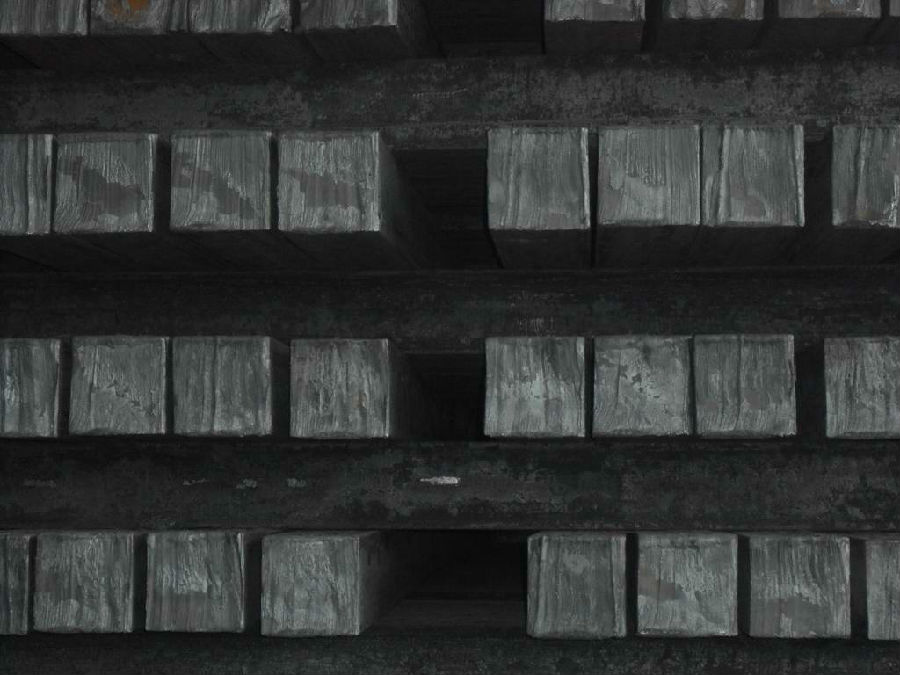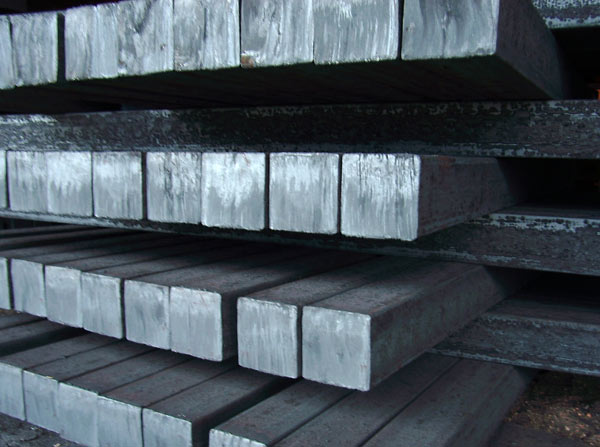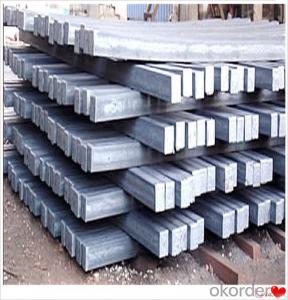Carbon Steel Billets Square Billets High Quality
- Loading Port:
- Tianjin
- Payment Terms:
- TT OR LC
- Min Order Qty:
- 24 m.t.
- Supply Capability:
- 24000 m.t./month
OKorder Service Pledge
OKorder Financial Service
You Might Also Like
Specifications
square steel billets 3sp & 5sp grade
1.3SP, 5SP
2.terms of payment: L/C at sight
3.size: 50~150mm
4.length: 5.8~12m
Specifications
| product name | square steel billets 3sp & 5sp grade |
| main types |
|
| size |
|
| application | 1.M.S. Billets are used for rolling of TMT Re-Bars of Fe415 and Fe500 Grade and various other structural steel products. 2.CRS Billets are used fro rolling of CRS TMT Re-Bars. 3.Special Alloy Billets are used for rolling of any special grade TMT Re-Bars like Earthquake resistant TMT Re-Bars and for special grade structural steel products. |
| notes | We produce world class quality steel billets which meets the specific requirements of the clients |



- Q: What are the main challenges in steel billet production?
- Manufacturers and producers face several key challenges in the production of steel billets. One of the primary hurdles is the need to guarantee a consistent and uniform quality for the billets. These semi-finished products are further processed into various steel items, and any irregularities or variations in their quality can lead to defects or failures in the final products. Consequently, it is crucial to maintain strict quality control measures throughout the production process. Another significant challenge revolves around optimizing the production process to meet desired quantity and quality targets while minimizing costs. This entails efficiently utilizing resources such as raw materials, energy, and labor. Additionally, striking a balance between production speed and quality can be challenging, as increasing the speed may result in reduced quality or increased defects. Ensuring the safety of workers and the environment also poses a major challenge in steel billet production. The production process involves heavy machinery, high temperatures, and potentially hazardous materials, which can jeopardize the health and safety of workers. To address this, it is imperative to implement proper safety protocols, provide training, and ensure compliance with regulatory standards. Furthermore, meeting the constantly growing demand for steel billets presents a challenge for producers. Market demand fluctuates, necessitating the ability to adjust production capacity accordingly. This requires flexibility in production planning and efficient inventory management to avoid overproduction or stock shortages. Lastly, technological advancements and innovations within the steel industry bring both challenges and opportunities. Incorporating new technologies, such as automation, artificial intelligence, and data analytics, can enhance efficiency and productivity. However, integrating these technologies into existing production processes can be complex and often requires substantial investments and expertise. In summary, the primary challenges in steel billet production include maintaining consistent quality, optimizing production processes, ensuring safety, meeting market demand, and adapting to technological advancements. Overcoming these challenges necessitates continuous improvement, innovation, and a proactive approach to remain competitive in the steel industry.
- Q: What are the different types of steel billet rolling mill defects?
- During the rolling process of steel billet in a rolling mill, various types of defects may occur. These defects can impact the final product's quality and performance and can have different causes. Some commonly observed defects include: 1. Surface defects: Scratches, cracks, pits, and scale are visible defects that can occur on the surface of the rolled billet. These defects can be caused by improper handling, insufficient lubrication, or excessive rolling pressures. 2. Shape defects: Deviations from the desired shape of the billet, such as bowing, twisting, or excessive tapering, are referred to as shape defects. Uneven cooling, improper alignment of the rolling mill, or incorrect rolling parameters can cause these defects. 3. Internal defects: Internal defects are not visible on the surface but can impact the structural integrity of the billet. Segregation, porosity, and inclusions are examples of internal defects. The presence of impurities in the raw material, improper heating or cooling, or inadequate quality control measures can cause these defects. 4. Dimensional defects: Deviations from the desired dimensions of the billet, such as variations in length, width, or thickness, are called dimensional defects. Improper calibration of the rolling mill, incorrect rolling parameters, or inadequate quality control measures can cause these defects. 5. Metallurgical defects: Metallurgical defects occur due to improper metallurgical processes during rolling. Grain size variations, improper grain flow, or undesirable microstructure are examples of metallurgical defects. Improper temperature control, inadequate alloying, or insufficient heat treatment can cause these defects. To ensure the production of high-quality steel billets, it is crucial for steel billet rolling mills to implement proper quality control measures. Regular inspections, testing, and monitoring during the rolling process can help identify and rectify these defects, thus minimizing their occurrence.
- Q: How do steel billets contribute to the manufacturing of furniture?
- Steel billets play a crucial role in the manufacturing of furniture by providing the essential raw material necessary for creating sturdy and durable frames. These billets are semi-finished steel products that are typically rectangular in shape and are produced through a process called casting or hot rolling. Once the steel billets are obtained, they can be further processed by different manufacturing techniques such as forging, extrusion, or machining to shape them into various furniture components. These components may include chair and table frames, bed frames, and other structural elements that require strength and stability. The use of steel billets in furniture manufacturing offers several advantages. Firstly, steel is known for its exceptional strength and durability, making it an ideal material for creating furniture that can withstand heavy loads and regular use. The use of steel billets ensures that the furniture is robust and long-lasting, reducing the need for frequent replacements. Additionally, steel billets provide flexibility in design as they can be easily shaped and molded into different forms. This allows furniture manufacturers to create intricate and unique designs that meet the aesthetic preferences of customers. Moreover, steel billets can be easily welded, allowing for the seamless joining of different components, resulting in a more cohesive and visually appealing final product. Furthermore, steel is highly resistant to corrosion, which is essential for furniture that may be exposed to moisture or environmental factors. The use of steel billets ensures that the furniture remains corrosion-free, maintaining its appearance and structural integrity over time. In conclusion, steel billets are indispensable in the manufacturing of furniture as they provide the necessary strength, durability, and flexibility required for creating sturdy frames and structural components. Their use allows furniture manufacturers to produce high-quality products that are long-lasting, visually appealing, and resistant to corrosion.
- Q: How are steel billets used in the production of construction equipment?
- Construction equipment production relies heavily on the use of steel billets. These semi-finished steel forms are essential in creating different components for construction equipment. The process of continuous casting is typically used to manufacture these billets, where molten steel is solidified in molds to form solid rectangular or square shapes. After obtaining steel billets, further processing is carried out to transform them into the desired construction equipment parts. This involves shaping, cutting, and machining the billets to create components like gears, shafts, axles, and structural frames. The versatility of steel allows these components to be customized to meet the specific requirements of different construction equipment. The utilization of steel billets in construction equipment production offers numerous advantages. Firstly, steel is known for its exceptional strength and durability, making it a perfect choice for heavy-duty applications. By incorporating steel billets, construction equipment manufacturers can ensure that their products can withstand the demanding conditions of construction sites and provide long-lasting performance. Additionally, steel billets can be easily welded, enabling the assembly of complex structures and components. This welding capability is crucial in construction equipment production, where multiple parts need to be securely joined together to create a robust and reliable machine. Furthermore, steel billets possess excellent machinability, allowing them to be easily shaped and formed into desired dimensions. This facilitates the precise manufacturing of intricate components, enhancing the overall performance and functionality of the construction equipment. Lastly, steel billets are readily available in a wide range of grades and compositions. This enables manufacturers to select the most suitable steel alloy for their specific construction equipment applications. This flexibility allows for the optimization of the equipment's performance, weight, and cost-effectiveness. In conclusion, steel billets play a crucial role in construction equipment production as they serve as the raw material for various components. Their strength, durability, weldability, machinability, and range of available alloys make them an ideal choice for manufacturing construction equipment that can withstand the demanding conditions of construction sites and deliver long-lasting performance.
- Q: What are the different surface treatments for corrosion resistance in steel billets?
- There are several surface treatments available for enhancing corrosion resistance in steel billets. These treatments are crucial in preventing the formation of rust and oxidation, which can significantly deteriorate the quality and lifespan of the steel billets. Some of the commonly used surface treatments for corrosion resistance in steel billets include: 1. Hot-dip galvanizing: This process involves immersing the steel billets in a bath of molten zinc, forming a protective coating on the surface. The zinc coating acts as a sacrificial layer, shielding the steel from corrosion. 2. Electroplating: This method involves depositing a thin layer of a corrosion-resistant metal, such as nickel or chromium, onto the steel billet's surface using an electrochemical process. The plated metal acts as a barrier, preventing direct contact between the steel and corrosive agents. 3. Passivation: This treatment involves treating the steel surface with chemicals, typically an acid solution, to remove any impurities or contaminants that may promote corrosion. Passivation creates a passive oxide layer on the surface, which provides corrosion resistance. 4. Powder coating: In this process, a dry powder is applied to the steel billet's surface electrostatically and then cured under heat. The powder melts and forms a protective layer on the steel, which offers excellent corrosion resistance. 5. Organic coatings: These coatings, such as paints or varnishes, are applied to the steel billet's surface. They provide a protective barrier against moisture and corrosive agents. Organic coatings can be customized to meet specific requirements in terms of color, texture, and durability. 6. Anodizing: This treatment is typically used for aluminum or aluminum alloy steel billets. It involves creating an oxide layer on the surface by subjecting it to an electrochemical process. The resulting anodized layer enhances corrosion resistance and also provides an aesthetic appearance. It is important to choose the appropriate surface treatment based on the specific requirements of the steel billets, considering factors such as the intended application, environmental conditions, and expected lifespan. Regular maintenance and periodic reapplication of the surface treatment may also be necessary to ensure continued corrosion resistance.
- Q: What are the different types of steel billet inspection equipment?
- The manufacturing industry utilizes various types of steel billet inspection equipment to guarantee the quality and integrity of the billets before further processing. These equipment are specifically designed for this purpose. 1. High-frequency sound waves are employed by Ultrasonic Testing (UT) Equipment to detect internal flaws or defects in the steel billets. It can identify cracks, voids, and other imperfections that may impact the final product's strength and performance. 2. Magnetic Particle Inspection (MPI) Equipment utilizes a magnetic field and specially formulated particles to identify surface and near-surface defects in the steel billets. It can uncover cracks, seams, and other imperfections that may not be visible to the naked eye. 3. Eddy Current Testing (ECT) Equipment uses electromagnetic induction to identify surface cracks and defects in the steel billets. It can detect variations in electrical conductivity caused by localized defects or changes in material properties. 4. Visual Inspection Equipment makes use of magnifying glasses, microscopes, and cameras to visually examine the steel billets for surface defects, irregularities, or other visual abnormalities. This equipment is often used together with other inspection methods for a comprehensive analysis. 5. Dimensional Measurement Equipment is employed to measure the dimensional accuracy and consistency of the steel billets. It includes tools such as calipers, micrometers, and laser scanners to ensure that the billets meet the required specifications and tolerances. 6. Surface Roughness Measurement Equipment quantifies the surface finish of the steel billets. It utilizes a stylus or laser to measure surface irregularities, providing crucial information about the billet's suitability for further processing. 7. X-ray Testing Equipment uses electromagnetic radiation to penetrate the steel billets and detect internal defects such as cracks, voids, or inclusions. This method is particularly effective for larger billets or when a comprehensive assessment of the internal structure is necessary. These are some of the commonly utilized steel billet inspection equipment in the manufacturing industry. Each type of equipment plays a vital role in ensuring that the steel billets meet the required quality standards and are appropriate for further processing into various end products.
- Q: What are the common alloys used in the production of steel billets?
- The common alloys used in the production of steel billets are carbon steel, stainless steel, and alloy steel.
- Q: What is the role of steel billets in the manufacturing of storage tanks?
- Steel billets play a crucial role in the manufacturing of storage tanks. These billets serve as the primary raw material for the construction of the tank's structural framework. They are essentially semi-finished steel products that are cast into a specific shape and size, typically in a rectangular or square form. The primary reason for using steel billets in the manufacturing of storage tanks is their exceptional strength and durability. Steel is renowned for its high tensile strength, which allows the tank to withstand the immense pressure and weight of the stored contents. Additionally, steel is resistant to corrosion, making it an ideal material for storage tanks that may hold various liquids or gases. Steel billets are also preferred for their malleability and versatility. They can be easily molded and welded into the desired shape, allowing for the customization of storage tanks to meet specific requirements. The flexibility of steel billets enables the construction of tanks of various sizes and capacities, accommodating different storage needs in industries such as oil and gas, chemical processing, water treatment, and many others. Furthermore, steel billets offer cost-effectiveness in the manufacturing process. The abundance of steel as a raw material and its recyclability contribute to lower production costs, making steel tanks a more economical choice compared to tanks made from other materials. Moreover, the longevity of steel tanks reduces maintenance and replacement costs over time, ensuring a higher return on investment for industries relying on storage tanks. In conclusion, steel billets play a vital role in the manufacturing of storage tanks due to their strength, durability, corrosion resistance, malleability, and cost-effectiveness. These billets form the core framework of the tanks, providing the necessary structural integrity to safely contain and store various liquids or gases. By utilizing steel billets, industries can rely on robust and reliable storage solutions that meet their specific storage requirements.
- Q: How are steel billets manufactured?
- Steel billets, which are essential raw materials for steel products like bars, rods, and wire rods, are produced using a widely used method in the steel industry called continuous casting. This process entails pouring molten steel into a mold that is cooled by water, causing it to solidify into a rectangular or square shape. The molten steel typically originates from a steelmaking furnace like a basic oxygen furnace or an electric arc furnace. Before the casting begins, the mold is heated beforehand to prevent premature solidification of the molten steel. Once prepared, the molten steel is poured into the mold using a ladle or a tundish to regulate the flow and eliminate impurities. When the molten steel enters the mold, it cools rapidly due to the water-cooled mold walls. This rapid cooling results in the outer layer of the steel solidifying and forming a solid shell. The cooling process continues as the steel progresses through the mold, and water is sprayed on it to expedite solidification. Once the solidified steel reaches the end of the mold, it is cut into desired lengths using a cutting torch or a mechanical shear. These solidified steel pieces, known as billets, are then transferred to a cooling bed or a roller table to continue cooling and solidifying. After sufficient cooling, the billets undergo inspection to identify any surface defects or irregularities. Depending on quality requirements, the billets may undergo additional processing, such as heat treatment or surface conditioning, to enhance their mechanical properties and surface finish. In summary, continuous casting enables the efficient and cost-effective production of steel billets, which are crucial raw materials for various downstream steel products.
- Q: What is the average production cost of steel billets?
- The average production cost of steel billets can vary depending on various factors such as the location, production scale, raw material costs, energy costs, labor costs, and other operational expenses. However, on a general basis, the average production cost of steel billets can range between $400 to $600 per metric ton. It is important to note that the production cost can fluctuate based on market conditions and the state of the global steel industry. Additionally, factors like technological advancements, efficiency measures, and economies of scale can also influence the production cost of steel billets. It is advisable for companies or individuals looking for accurate and up-to-date information on the average production cost of steel billets to consult industry reports, market analysts, or relevant trade associations. These sources can provide more specific and detailed data tailored to a particular region or market segment.
Send your message to us
Carbon Steel Billets Square Billets High Quality
- Loading Port:
- Tianjin
- Payment Terms:
- TT OR LC
- Min Order Qty:
- 24 m.t.
- Supply Capability:
- 24000 m.t./month
OKorder Service Pledge
OKorder Financial Service
Similar products
Hot products
Hot Searches
Related keywords




























